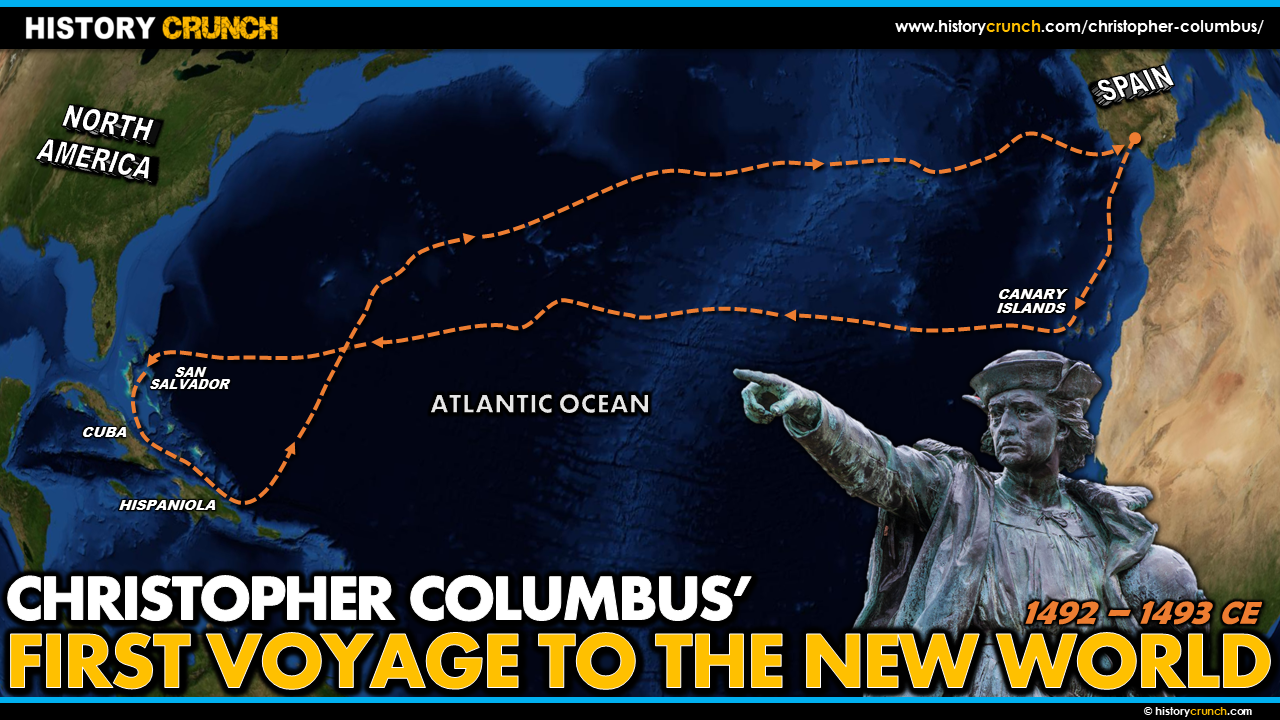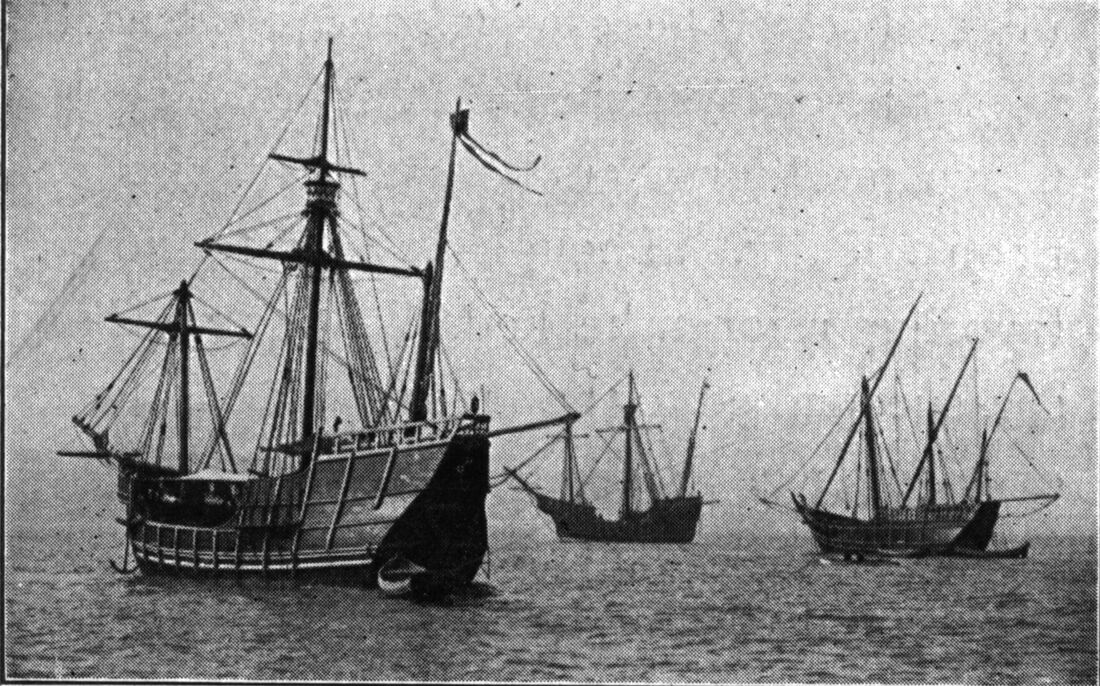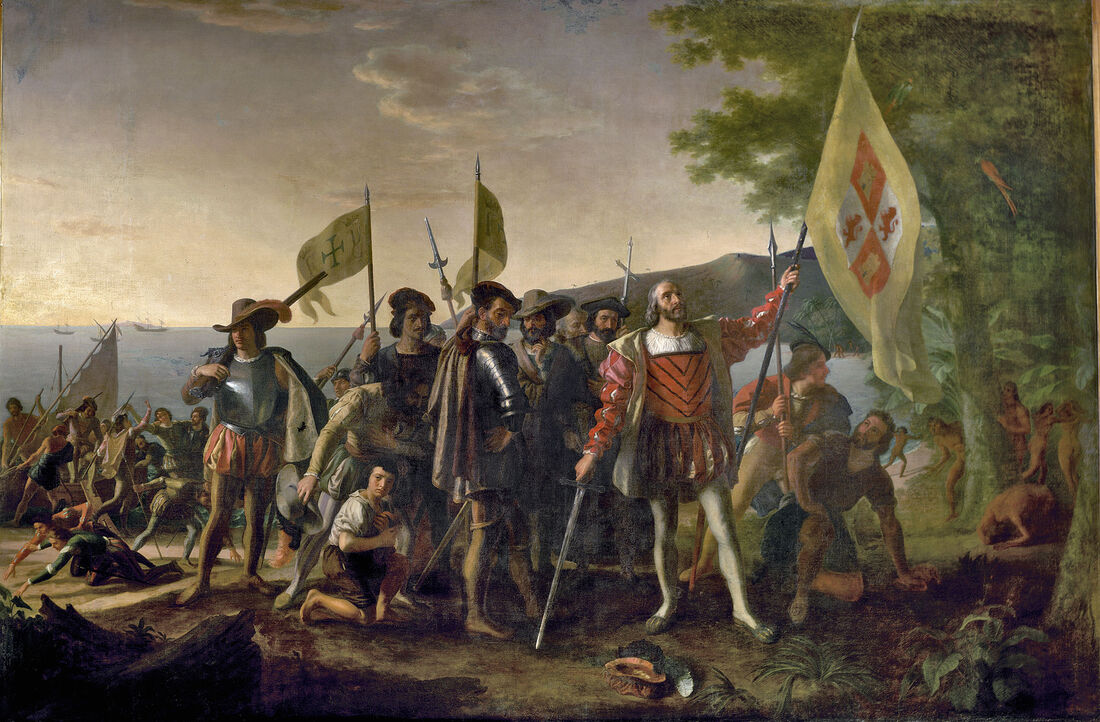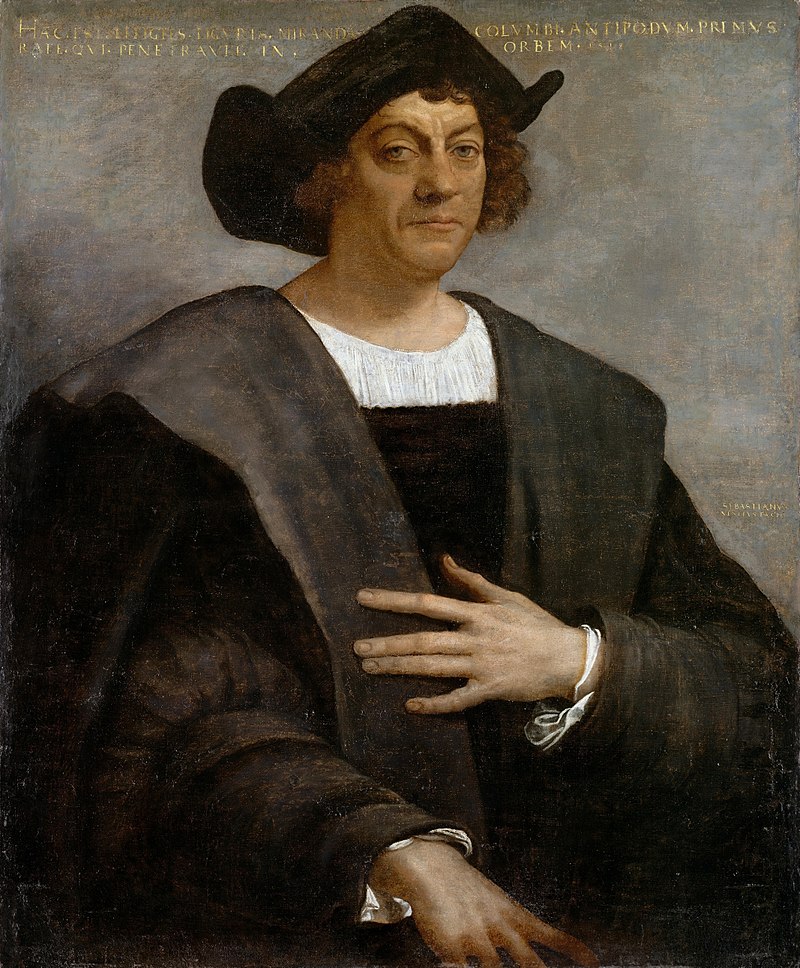CHRISTOPHER COLUMBUS' FIRST VOYAGE
In total, Christopher Columbus carried out four voyages to the New World between 1492 and 1503. These four voyages are incredibly significant in the history of the world, as they mark the beginning of European exploration in the New World and led to other major events, such as: the Columbian Exchange, and the mass migration of European settlers to the Americas. All four voyages were financed by the Spanish monarchs and caused other powerful European nations such as England, France and Portugal to carry out their own explorations of the New World.
Christopher Columbus’ first voyage westward from Europe began in 1492, following his financing deal from the Spanish king and queen – Ferdinand and Isabella. He left Spain on August 3rd, 1492 with three ships. The largest was a carrack named ‘Santa Maria’ and was a three-mast ship that stretched about 58 feet (17.7 meters) in length. It was the flagship of Columbus’ first voyage. Accompanying the Santa Maria were two others ships that were caravels, which was a small but more maneuverable type of sailing ship. The first of these is called ‘La Pinta’, which means ‘The Painted One’. ‘La Pinta’ is actually a nickname for the ship, as the original name has been lost to history. It was supposedly the fastest of the three ships. It was approximately 56 feet (17 meters) in length. The second caravel on Columbus’ first voyage was nicknamed ‘La Nina’ which means ‘The Little One’. In reality, the name on the ship was ‘Santa Clara’, and had been given the nickname in reference to its owner. It was the smallest of the three ships and supposedly only stretched 50 feet (15 meters) in length. Regardless, all three ships were considered to be medium-sized and were designed for use in and around the Mediterranean Sea. This means that they were not meant for use on the open ocean.
After leaving Spain, Columbus and his crew sailed the three ships to the Canary Islands, which were controlled by the Spanish monarchs at the time. The islands are located south of Spain in the Atlantic Ocean and sit just 62 miles (100 kilometers) west of the country of Morocco. Columbus had his ships repaired and restocked while there until September 6th, 1492 when they departed for their crossing of the Atlantic Ocean.
The crossing of the Atlantic took the three ships about five weeks. Columbus’ knowledge of the winds present in the Atlantic Ocean allowed the three sail ships to use the ‘easterlies’ to sail west from the Canary Islands until the ships reached the Caribbean. Although, it should be noted that this path combined with the time of the year made the three ships susceptible to mid-Atlantic storms and hurricanes. Columbus and the crew appear to have avoided them on their first voyage by mere chance.
Columbus and the crew knew that they were nearing land by the different items they found floating in the water. For instance, Columbus noted the following in his journal on October 11th, 1492: “The crew of the Pinta saw a cane and a log; they also picked up a stick which appeared to have been carved with an iron tool, a piece of cane, a plant which grows on land, and a board. The crew of the Nina saw other signs of land, and a stalk loaded with rose berries. These signs encouraged them, and they all grew cheerful. Sailed this day till sunset, twenty-seven leagues.”
|
Regardless, on the morning of October 12th, 1492, a lookout (Rodrigo de Triana) aboard the Pinta notified the crew that he had spotted land. The captain of the Pinta fired a cannon shot to notify Columbus aboard the Santa Maria of the discovery. Although, Columbus later claimed he personally made the discovery of the land hour earlier.
Columbus named the land upon which the three ships arrived ‘San Salvador’ which translates to ‘Holy Savior’, however the local native people that Columbus and the crew first encountered referred to it as ‘Guanahani’. Modern historians debate which exact island it is that Columbus first arrived at but it was one of several possible islands in the northeastern Caribbean.
|
Upon arriving in the Caribbean, Columbus and the crew encountered several different groups of indigenous peoples, including: Lucayan, Taíno, and Arawak. Believing he had arrived at the Fareast of Asia, Columbus referred to the people he came across as ‘indios’, which translates to ‘Indian’ in English. In fact, in a report on his first voyage he wrote that he believed he was sailing in the Indian Ocean. “On the thirty-third day after leaving Cadiz I came into the Indian Sea, where I discovered many islands inhabited by numerous people. I took possession of all of them for our most fortunate King by making public proclamation and unfurling his standard, no one making any resistance.” Columbus’ error persists to this day, as indigenous peoples in the Americas (especially in Canada and the United States) have been referred to as Indians for much of the time since Columbus’ arrival. With that said, the term is generally considered inappropriate today as indigenous peoples in the United States are most commonly referred to as Native Americans, while in Canada they referred to as First Nations. Columbus believed that he had arrived in Asia because he had miscalculated the circumference of the Earth. When Columbus set sail in 1492, it was widely understood that the Earth was a sphere and not flat. Also, several different people previous to Columbus had correctly calculated the circumference of the Earth, which is 25,000 miles (40,000 kilometers). However, a confusion in different types of measurements led Columbus (and other Europeans of the time) to incorrectly estimate the circumference of the Earth to be much smaller than it actually is. As such, when Columbus arrived in the New World, he believed he had in fact arrived in Asia due to the distance he had travelled and his belief that the Earth was smaller than it really is.
|
In his journal, Columbus noted that the people he encountered were peaceful and friendly. For instance, Columbus made an entry in his journal on October 12th, 1492 in which he commented:
“Many of the men I have seen have scars on their bodies, and when I made signs to them to find out how this happened, they indicated that people from other nearby islands come to San Salvador to capture them; they defend themselves the best they can. I believe that people from the mainland come here to take them as slaves. They ought to make good and skilled servants, for they repeat very quickly whatever we say to them. I think they can very easily be made Christians, for they seem to have no religion. If it pleases our Lord, I will take six of them to Your Highnesses when I depart, in order that they may learn our language.” This highlights the controversial nature of Christopher Columbus today as while some celebrate him for his accomplishments, many others also condemn him for his treatment of the indigenous peoples that he encountered. For instance, he further commented that “these people are very simple in war-like matters… I could conquer the whole of them with 50 men, and govern them as I pleased.” |
He continued his journey on his first voyage by heading west and south to where he arrived on the eastern coast of Cuba on October 28th, 1492. From there he continued east to Hispaniola, which he and his crew arrived at on December 5th. The island of Hispaniola is the second largest island in the Caribbean after Cuba. Today, it is the location of the countries of Haiti and the Dominican Republic. The Santa Maria ran aground off the coast of Hispaniola and was later used to establish the settlement La Navidad. In fact, the island of Hispaniola was first permanent European settlement in the Americas. Columbus left nearly forty of his crew at La Navidad to construct the settlement. He would not return to the settlement until 1493 on his second voyage to the New World. Regardless, while on Hispaniola, Columbus encountered more indigenous people, some of which he took prisoner. After exploring the northern coast of Hispaniola for a few more weeks, Columbus and his crew returned to Europe aboard the two remaining ships - La Pinta and La Nina.
The journey home to Spain was not without incident as the two ships battled storms. However, he arrived back to Spain on March 15th, 1493 and became famous for his incredible journey and findings. In fact, Columbus had written a letter while still aboard the ships on the return trip home, which was later published and spread news of the voyage throughout the rest of Europe. In the letter, he discussed his findings, including wealth and people. As well, he wrote about his belief that he had sailed to the Indian Ocean and that we had arrived near mainland China. The letter was important in helping spread the news of Columbus’ discovery and inspired others to follow in his footsteps. It also helped Columbus gain support for a second voyage to the New World in late 1493.
CITE THIS ARTICLEAUTHOR
|
|




